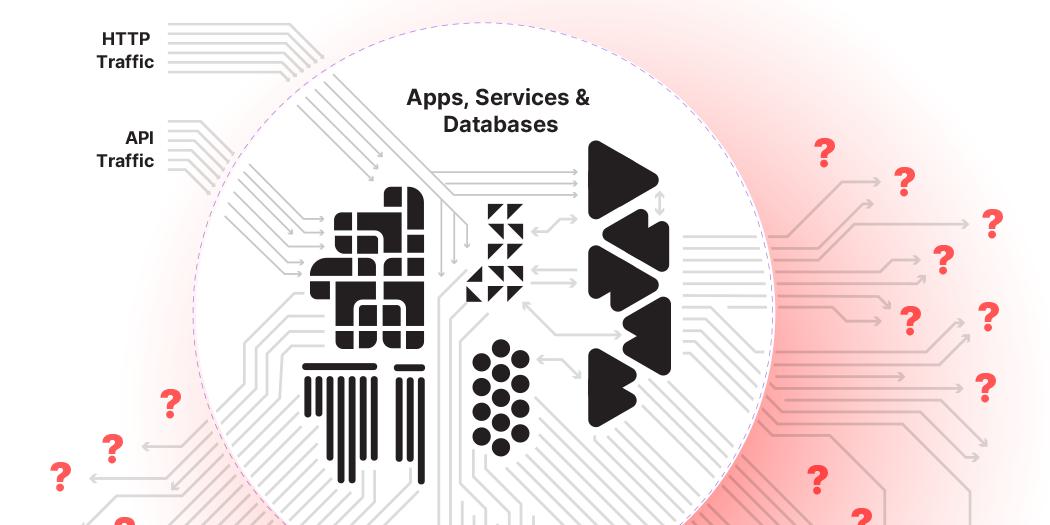Conquering the Hidden Challenges of External Service Integrations


The surge in third-party integrations has introduced a host of new challenges for operators:
- Your app’s reliability now depends on the stability of external services.
- Diagnosing problems now means untangling a maze of dependencies.
- Blind spots in external requests and payloads are a ticking time bomb for data governance.
Legacy tools weren't built to handle the growing complexity of today’s interconnected tech landscape.
Navigating the Challenges of Outbound Application Traffic
To keep your modern, highly connected applications running smoothly, it's crucial to navigate the complexities of outbound application (egress) traffic, as this is where many of the performance, security, and reliability issues begin to surface.
Understanding Egress Traffic
Egress traffic, the outbound data flow from your applications to third-party APIs, managed services, and other dependencies, has become a critical component of modern application architecture. However, visibility into this egress traffic is often limited, leading to blind spots in managing performance and security. Traditionally, egress traffic is left largely unmonitored, with open policies that starkly contrast the tight controls placed on inbound traffic. This lack of visibility can obscure critical insights into how your application interacts with external services, making it difficult to troubleshoot issues or enforce security policies effectively.
Limitations of Current Approaches
Current approaches to managing egress traffic often rely on network-level controls like firewall rules and access lists, which are cumbersome and disconnected from the way developers understand their applications. These methods focus on IP addresses and CIDR notations, offering little insight into the actual behavior of outbound traffic. This disconnect leaves developers and operators blind to how protocols, domains, and libraries are interacting with external services, resulting in inefficient troubleshooting and security gaps that are difficult to close.
The Need for a New Solution
The lack of accessible tools for managing external dependencies and traffic flows has created a significant challenge ops teams. Current solutions are complex, requiring expertise across various aspects of infrastructure and often failing to provide the real-time visibility needed by developers and operations teams. Bridging this gap with a solution that leverages enhanced visibility into egress traffic is crucial—not just for security, but also for reliability and efficient troubleshooting.
Overcoming External Service Integration Challenges with Qpoint
Qpoint aims to bring a higher level of sophistication to how operators manage the interactions between their production applications and their external service dependencies. By enabling operators to tap into their egress traffic with cutting edge eBPF technology, questions like the following can be answered:
- Which external services are my applications connecting to?
- What are the payloads? Do they contain sensitive data?
- What protocols are being used (TCP, HTTP, HTTPS)?
- When are we connecting to previously unknown endpoints?
- Which vendor is responsible for our current outage?
- Are we about to be throttled due to a rate limit?
- What is the set of API tokens that is currently being used for external requests?
Powered by eBPF
Qpoint leverages an eBPF probe (Qtap) to tap into your egress traffic directly on the host without affecting performance. Think of Qtap as a smart, invisible observer that watches all outgoing traffic, answering crucial questions about who's sending data, what's being sent, and where it's going. It's perfect for organizations looking to gain insights without changing their existing infrastructure.
Key benefits:
- Non-intrusive monitoring
- Minimal performance impact
- Comprehensive traffic visibility
Qtap also supports the Qpoint middleware engine which allows you to seamlessly inject custom functions and execute complex traffic manipulations out-of-band from your primary request flow.
Revolutionize How Your Team Manages External Service Interactions
As the digital landscape evolves, so must our approach to observability and data security. Qpoint offers a comprehensive solution to the often-overlooked challenge of managing the interactions between your core applications and their critical external service dependencies. By providing unprecedented visibility into outbound data flows, enabling custom controls, and offering flexible deployment options, Qpoint empowers an operations team to:
- Maintain an inventory of vendors that is the source of truth for the organization
- Monitor traffic, detect errors, and trigger alerts in real time if there is anomalous activity
- Enable developers to swiftly pinpoint and resolve production issues
- Optimize performance and costs associated with external services
- Ensure compliance with data protection regulations through systematic detection of sensitive data in external traffic
Don't let your external dependencies and vendor relationships remain an overlooked area of risk and lost productivity for your organization. Take the first step towards comprehensive visibility and control over your applications' interactions with external services. Visit our documentation to learn more or contact us today for a personalized demo and discover how we can tailor our solution to your specific needs.